INTRODUCTION
The Messerschmitt Me 262 ‘Schwalbe’ (“Swallow”) is undoubtedly one of the most important examples of Germany’s technological advancement in both aerodynamics and jet engines during the Second World War. But the entry into operational service of the first jet fighter in history was delayed by a tumultuous and difficult development, mostly due to engine troubles and political decisions. Thinking that the war would be short, the Third Reich never granted it any priority. But once they were confronted with the possibility of a defeat, it was too late to produce it in sufficient numbers, train the pilots and have any significant effect on the outcome of the war.
This article is by Menetrey Yann from Switzerland, a guest author for Defencyclopedia.
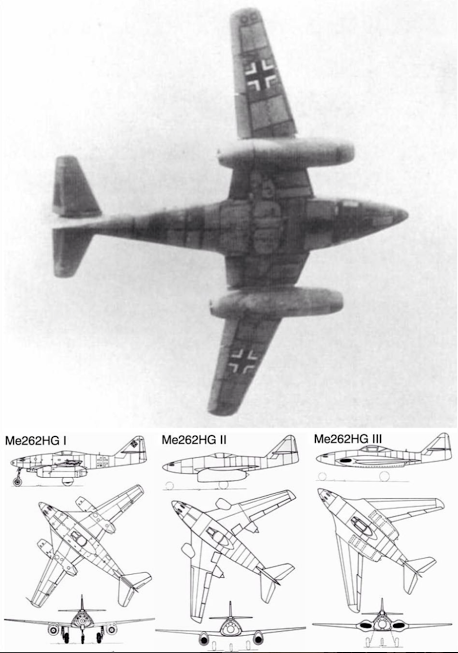
Me 262
DEVELOPMENT
Work on the Me 262 started before WW2 in 1938, but as an experimental aircraft. After the successful test flight of the world’s first jet powered aircraft, the Heinkel He 178, Germany adopted jet engines for an advanced fighter. Renamed ‘Projekt 1065’, the Me 262’s development progressed slowly due to difficulties encountered with the development of the BMW 003 jet engine which could only produce half of the expected output. While the Me 262 prototype was ready to fly, there were no power plants available to take it to the sky. This postponed the first flight of the Me 262 V1 prototype to the 18th of April 1941. The V1 was equipped with a Jumo 210G piston engine in the nose and two mock BMW 003 under the wings and only served to test the aerodynamics of the fighter.
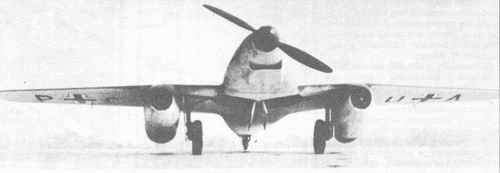
On 29 July 1942 finally occurred the first flight with jet engines, more than a year after the completion of the airframe. The V3 prototype was powered by two BMW 003 producing 750kg (1,650lb) of thrust each and fitted with a classic tail wheel. This landing gear layout proved inadequate as the aircraft couldn’t leave the ground. While accelerating, brakes had to be applied to raise the tail of the prototype and allow it to take off. The V3 thus received a redesigned tricycle landing gear to be in a horizontal position during take off and test flights continued slowly.
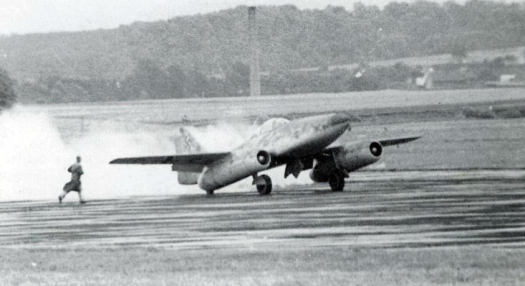
The Germans produced two jet engines during the war: the BMW 003 and Jumo 004. Unlike the British, the Germans favoured axial-flow turbojet over centrifugal compressor turbojet. The axial-flow engine was far more powerful and had a smaller cross-section (important for high-speed aircraft) but was more fragile and complex to manufacture. The development of the BMW and Jumo engines was made in parallel, and both proved to be unreliable.
At first, the BMW 003 was the planned engine for the Me 262. Delays and problems in its development led Messerschmitt to choose the Jumo 004 instead. In the end, the BMW 003 only powered two V-prototypes and two production Me 262 A-1b. The Jumo 004, despite having its own development problems, entered production well ahead of its more technologically advanced competitor. Jumo’s jet engine had a smaller diameter but was heavier than the BMW 003.
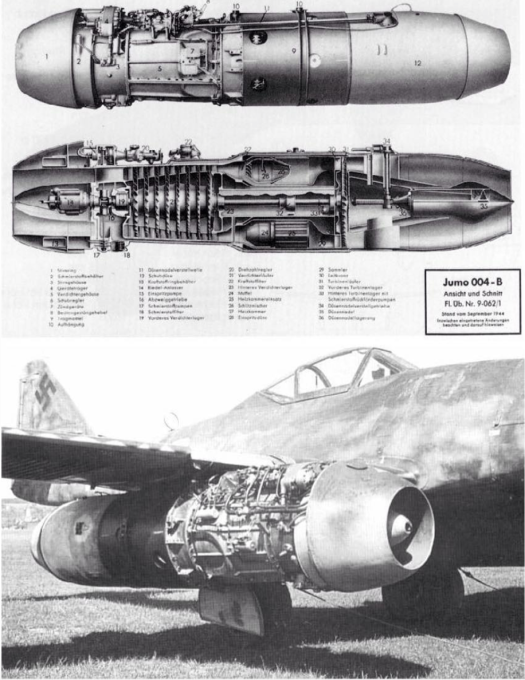
The wing of the Me 262 had thus to be redesigned to maintain the centre of gravity. To resist high temperatures in the engine, scarcely available materials were used, which were unacceptable in production. To address this problem, a sheet of aluminium was applied over mild steel. The engine was easier to produce, but its lifespan was shortened, not exceeding 15 hours. The Jumo 004 could produce 900kg (1’900lb) of thrust.
But in summer 1943, Hitler wondered if the Me 262 could be designed as a fighter-bomber. In fact, Hitler was giving more importance to a fleet of versatile aircraft capable of both intercepting enemy fighters and attack troops attempting an invasion of German-held territory before his Panzer divisions could repel it. Messerschmitt indicated it was impossible for the Me 262 to carry bombs in its current state and that it would require major modifications. Furious, Hitler ordered that every Me 262 had to be produced as a fighter-bomber.
Modifications were effectuated and two 250kg (500lb) bombs could be carried, becoming the Me 262A-1b/2a version. However, this improvised solution occasioned an excessive delay in the deployment of the Me 262. The jet fighter was thus never ready for the expected landings in Normandy, the very invasion Hitler wanted it to counter. The operational interest in the fighter-bomber version quickly fell and the Germans abandoned its production in favour of its initial interceptor version, the Me 262 A-1a.
ARMAMENTS AND DIFFERENT VARIANTS
Messerschmitt thought of its jet fighter as a bomber interceptor. To make short work of Allied heavy bombers, a powerful armament had to be mounted. The nose of the Me 262 had enough space to accommodate a wide variety of armament layout, depending on the version and the role it was intended to fulfil. In 1942, Rheinmetall-Borsig submitted its newly developed 30mm Mk 108 cannon, specially designed for use against heavy bombers. The cannon could fire the ‘Minengeschoss’ (“mine-shell”), a shell with a warhead filled with powerful RDX explosive, making it highly lethal against bombers. Three of these strongly brisant high-explosive ammunitions were enough to take a heavy bomber down.

The first armament trials with the Mk 108 were effectuated with the V8 prototype in March 1944. The Me 262 received not less than four Mk 108, each fed with 100 rounds, giving it the heaviest armament of any WW2 fighter. 45kg of lethal projectiles could be fired in a 3 seconds burst. In comparison, the Hawker Tempest could “only” fire 18kg with its four Hispano 20mm cannons. However, the Mk 108 had a low muzzle velocity and was prone to jamming.
To overcome the limitations of the usual quartet of Mk 108 mounted on the Me 262A-1a, another armament compartment was designed. Mounted on the Me 262A-1/U1, it featured two 20mm MG 151 cannons, two 30mm Mk 103 cannons and two Mk 108. The combination of the different cannons was problematic and only three examples of the Me 262A-1a/U1 were built. Another compartment was tried and fitted on the Me 262A-1/U5, featuring six Mk 108 cannons. But this solution was found too heavy and couldn’t store much ammunitions for the cannons. Only one example was built.
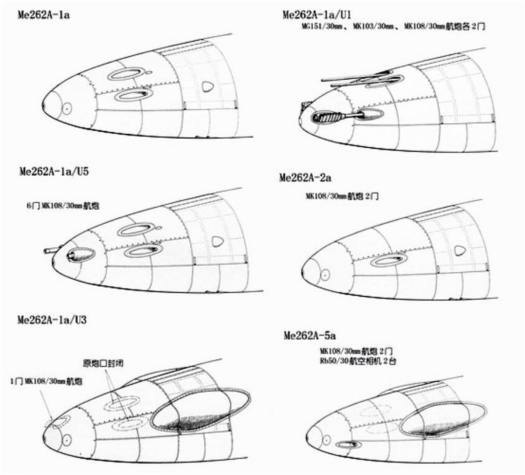
The different nose variants of the Me 262
The Me 262A-2a was the definitive fighter-bomber version, capable of carrying two SC500 500kg (1,000lb) bombs. Only two Mk 108 cannons were retained on this version. Messerschmitt also developed a reconnaissance version of the Me 262, starting with the Me 262A-1a/U3. This model could be distinguished by its bulge over the gun bay area which held two RB20/30 cameras. A single Mk 108 could be fitted but all twenty-six airframes were unarmed. The Me 262A-5, the final reconnaissance variant, could carry two Mk 108 cannons, but only a few were produced before the end of the war.

The armament was completed by 24 R4M rockets mounted on wooden racks under the wings. The R4M was a simple, small rocket-propelled missile that served almost exclusively on the Me 262. It had the advantage of being more practical than the large Werfer-Granate 21, had a higher velocity than 30mm shells but kept the same ballistic trajectory than the Mk 108 shells, making the aim easier. 12 were fitted under each wing and R4Ms were generally fired in a salvo of six rockets. Since their accuracy was limited, six rockets were enough to cover roughly the size of a heavy bomber, almost guaranteeing a hit.
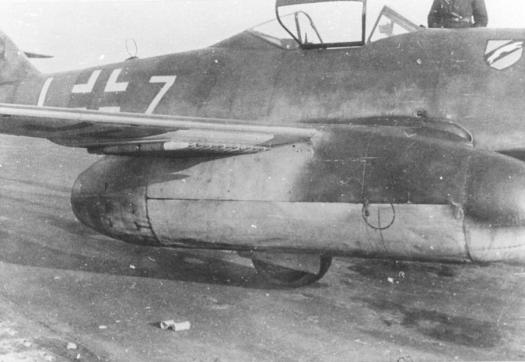
SPECIAL VARIANTS
Starting with one of the most atypical (and popular) versions of Messerschmitt’s jet fighter, the Me 262 A-1a/U4. The U4 version was nicknamed “Pulkzerstörer” (“formation/pack destroyer”) and would have probably been the bomber-destroyer by excellence. Two airframes were taken off the production line, fitted with new nose sections and became the prototypes of the A-1a/U4. Flight tests were carried out in May and April 1945. The major difference between the “Pulkzerstörer” and an ordinary 262 is obviously the entire nose section that had been specially designed to accommodate the Mauser Mk 214A 50mm cannon.

Weighing 490 kilos (1,000lb) and with a rate of fire of 45 rounds/minute, it could carry 22 projectiles. Just like for the Mk 108, the Mk 214 could fire shells fitted with powerful RDX explosive. Only one of these large 50mm shells was enough to effectively destroy a bomber. The size of the gun meant that the nose wheel mechanism had to be reconstructed and the nose wheel swivelled 90 degrees to lay horizontally in the bay beneath the gun when fully retracted.
This layout had already been developed for the Messerschmitt Me 309 and adapted for the Me 262. The cannon was accessed by removing a large hatch along the upper nose and the otherwise so sleek outlines of the 262 were marred by a hump covering the foremost parts of the gun. The barrel itself protruded from the nose of the aircraft, making it look like a giant vicious insect.
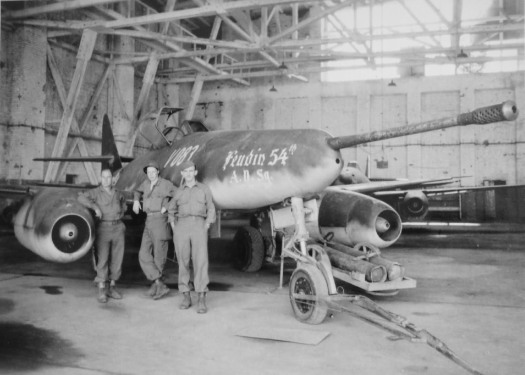
Even if the Mk 214 was the planned cannon for the Me 262, only one of the two airframes received it while the other was tested with the BK5, already in use with the Messerschmitt Me 410. Both cannons were highly powerful, allowing them to be accurately fired from long ranges, well outside the range of the defensive guns mounted on the bombers. With its speed advantage and tremendous power, the U4 would have surely been one of the worst nightmares of Allied bomber crews.
Check out some original gun camera footage from the Luftwaffe Me 262s
Another interesting variant is the two-seater one. The Messerschmitt Me 262 was a very delicate fighter to fly, requiring skills and experience. Early jet engines were less reactive than piston engines at low speed, making landings tricky for young pilots. A tandem-seat trainer version of the Me 262 was thus desirable and greatly eased the conversion of pilots on the jet fighter.
A second seat and dual controls were fitted, replacing one of the fuel tanks. This became the Me 262B-1a version which was introduced in the summer of 1944. Only fifteen airframes were built. However, the Me 262B-1a led to the development of an impressive night fighter variant, the Me 262B-1a/U1. A FuG-218 ‘Neptun’ long-wavelength radar was fitted along the ‘Naxos’ centimetric-radar-homing gear. The ‘Neptun’ was only a stop-gap before the improved Me 262B-2 fitted with the advanced FuG 240 ‘Berlin’ airborne interception radar was ready. The ‘Neptun’ was still capable of detecting a target between 100m and 5000m and was covering a 120° angle. However, its characteristic antennas were slowing the Me 262, but the latter was still capable of a max speed of 750km/h (470mph), still faster than the feared British De Havilland Mosquito which preyed on German night fighters.
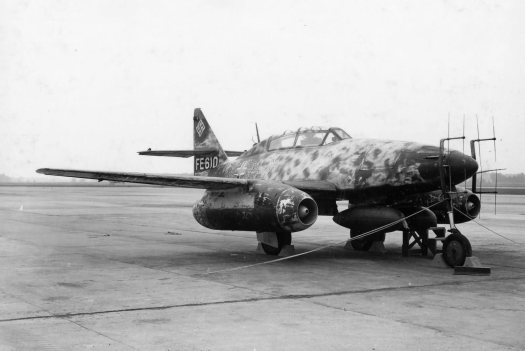
To fit the radar in the nose, the two upper 30mm Mk 108 cannons were replaced by two 20mm MG 151 cannons but the two lower Mk 108 were retained. With the second seat, the Me 262 had lost a fuel tank, which greatly reduced its already short range. A good night fighter had to be capable of staying in the air and patrol for hours, so two 300L (80 US gallon) external fuel tanks were fitted under the forward fuselage, greatly extending the fighter’s range.
Trials started in October 1944. However, the Me 262B-1a/U1 didn’t see combat before April 1945. The NJG 11 ‘Kommando Welter’ was already flying the Me 262 A-1a fighter variant as an experimental jet night fighter unit and received ten Me 262 B-1a/U1 in April. Some accounts claim that these night fighters participated in the defence of Berlin and shot down some RAF De Havilland Mosquitos, but there is no confirmation of such claims.
AERODYNAMICS AND FURTHER DEVELOPMENT
Let’s get a bit technical here and speak about the aerodynamics of the aircraft. The Me 262 was already featuring some technological revolutions but considering how far German researchers in aerodynamics were at the time, the fighter wasn’t that advanced. Messerschmitt’s jet was first supposed to receive wings with a 35° sweep and two BMW 003 engines. As the Me 262 was finally powered by two Jumo 004 which were heavier, the wings had to be modified with an 18° sweep to keep the centre of gravity of the aircraft.

But what’s special with the angle of a swept wing? When an aircraft approaches supersonic speeds, the pressure on the wings increases brutally, increasing the drag as well. This phenomenon is called ‘compressibility’ and can be fatal for aircraft as they become nose-heavy and enter a vicious dive. When the compressibility limits of an aircraft are reached, surface controls become fixed. The pilot loses control of his aircraft which enter in a steeper dive, leading to the crash or disintegration of the plane in the air.
Swept wings have a crucial advantage: their compressibility ratio is much higher, allowing higher speeds. The sweeper the angle is, the higher the compressibility ratio is. This was discovered by the Germans in 1935, and further researches were immediately carried out. But an 18° sweep wasn’t enough for the Me 262. Its pilots were forbidden to enter 90° dives or reach speed in excess of 900km/h, otherwise, the fighter would be out of control. Messerschmitt was well aware of this and started to work on the HG versions (Hochgeschwindigkeit, or “high-speed”) in 1943.

The Me 262HG I had a wider chord of the inner wing section thanks to the insertion of a fillet increasing the angle of sweep between the engine nacelles and the fuselage. A new low-drag cockpit canopy and swept horizontal tail surfaces were designed. Flight tests started in January 1945 with the Me 262 V9 modified to the above standards. Tests were satisfactory but the new tail section gave rise to problems. The Me 262HG II received a new wing with the originally planned 35° sweep, improved engines nacelles, the low-drag canopy and the swept horizontal surfaces.
Messerschmitt also investigated a “V-tail” version. Extensive wind tunnels tests were effectuated and the Me 262HG II prototype was about to start flight trials but was damaged in a ground accident. The Me 262HG III incorporated a new wing with a 45° sweep, a centralised engine installation in the wing roots which would have greatly reduced drag, the low-drag canopy and the swept horizontal tail surfaces. The HG I and II were made to gain experience in high-speed flight while the HG III would have been the ultimate version of the Me 262. The top speed of the HG III was projected as Mach 0.96 (1,185km/h, 736mph). After extensive wind tunnels tests, construction of the HG III prototype started but wasn’t completed before the war’s end. And this is how ends the story of the first operational jet fighter’s development.
About the Author
Yann Menetrey is a 21 years old university student living in Geneva, Switzerland. Fascinated by aviation since childhood, and later by military history, he’s running @the_ww2_gallery since three years, an Instagram account dedicated to the Second World War.
Edited and formatted by N.R.P
Enjoyed reading the article? Do rate it below. And don’t forget to download our app!
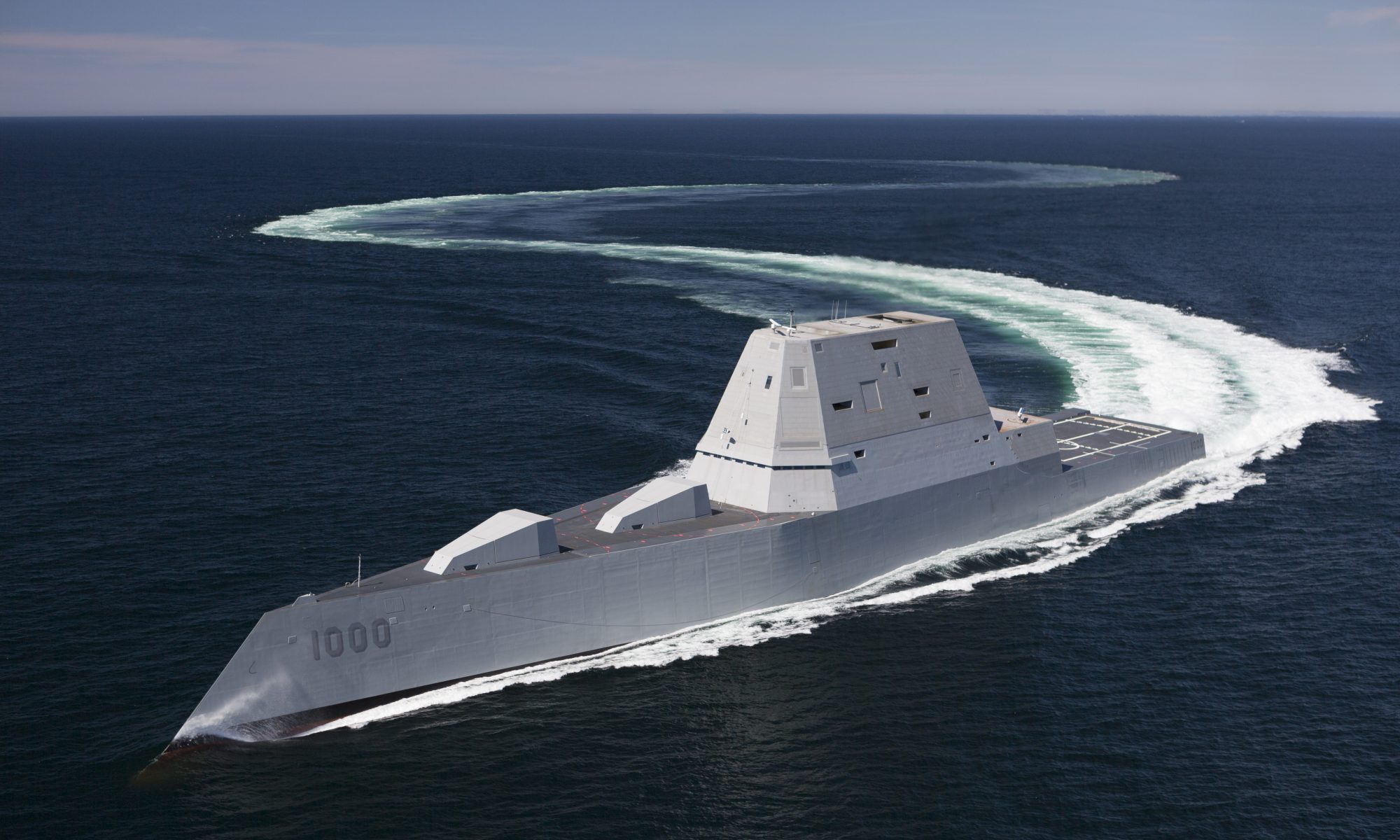


A fine article. As always I look forward to the next one.
LikeLiked by 1 person
Nice article. 🙂
LikeLiked by 1 person
very informative.
LikeLiked by 1 person
Is it true that Me 262 took away the essential war effort towards more conventional Fighters that can be made in numbers .
LikeLike
was born restriction on Germany should remove and brilliant intelligence of the nation should be permitted to flow.
LikeLike